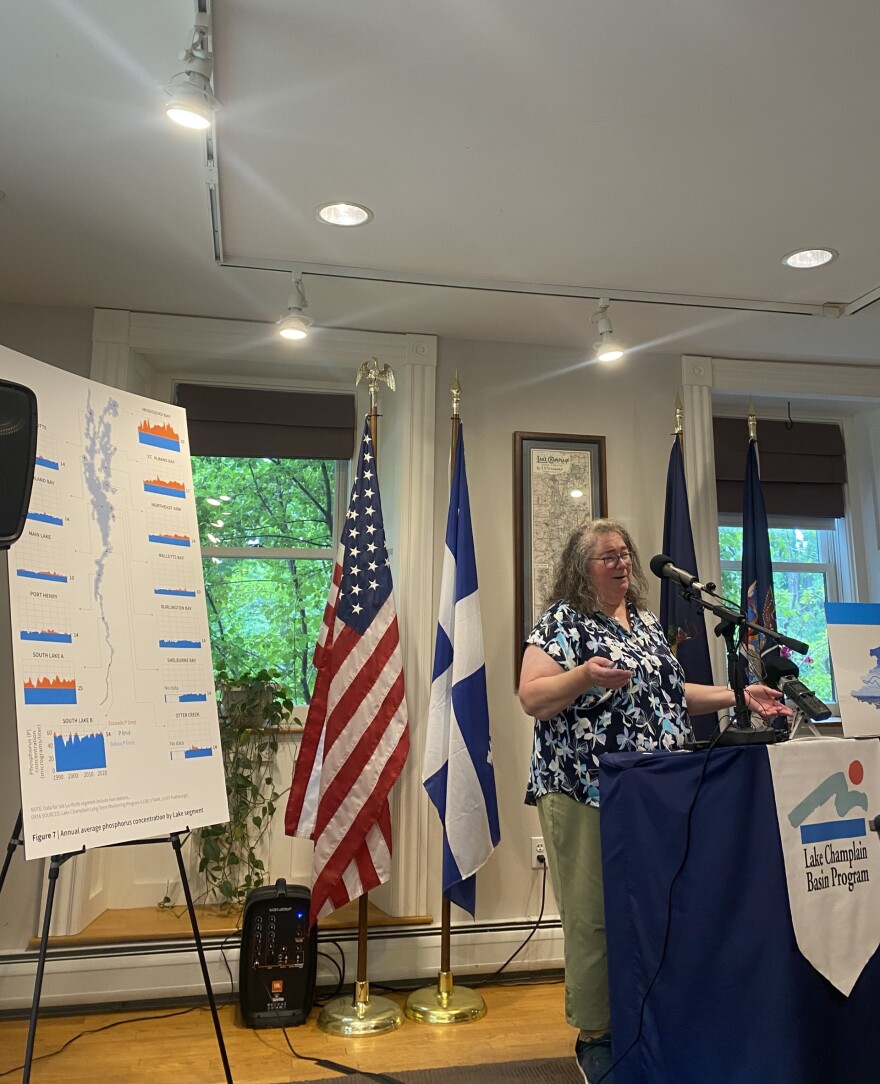The health of Lake Champlain has largely recovered from waste and nutrient deposits after the 2023 floods, according to a new report published this week by the Patrick Leahy Lake Champlain Basin Program.
The “State of the Lake and Ecosystem Indicators Report” also outlines the status of invasive species and the state of water quality.
The reports are compiled every three years and designed to give a comprehensive and digestible picture of Lake Champlain’s health. The reports also serve as a tool to identify trends and patterns in how the lake is doing over time.
The report tracks the presence of cyanobacteria, also called blue-green algae. Cyanobacteria is native to Lake Champlain but can sometimes produce toxins hazardous to humans and wildlife if ingested. When algae blooms are spotted at public beaches, it is recommended that the site be closed for swimming.
However, most closures are strictly precautionary. The "State of the Lake" report says only a small percentage of bloom sites are actually toxic. In a 2021-2023 monitoring initiative, 28 out of 172 water samples contained traces of the cyanotoxins. Only four had levels above the public safety threshold levels.
Cyanobacteria grows in colonies called blooms and looks like splotches of spilled pea soup on the surface of the water. It is fueled by warm water temperatures and feeds on the nutrient phosphorus.
“The Lake Champlain Basin Program and our partners are addressing the root cause of cyanobacteria blooms by working to limit the levels of nutrients in the Lake,” said Matthew Vaughan, technical coordinator at the Lake Champlain Basin Program.
High phosphorus levels and their direct correlation to blue-green algae blooms have long been a focal point for lake health efforts.
But during last July’s historic flood events, 300 billion gallons of water flooded the Lake Champlain basin, depositing more than 200 metric tons of phosphorus into the lake.
“This total is roughly half of the annual target phosphorus load in one week, and about 1/3 of that was delivered in just a single day,” Vaughan said.
The lake experienced a 3-foot rise in water level due to a 1,000% increase in river flow between July 9 and 11 last year. The watershed also brought untreated wastewater into the lake when over 30 wastewater treatment facilities in the state were impacted.
“Testing did not find widespread bacteria contamination in the Lake following the July 2023 flood,” the report states, “though levels above the public safety threshold were detected at the mouth of the Winooski River for two weeks following the storm.”
As for the phosphorus levels, according to the report, monitoring in the weeks following the summer storms showed “a return to typical nutrient levels throughout the Lake, and most of the 2023 season showed typical phosphorus concentrations.”
The ongoing challenge of phosphorus
Now, nearly a year later, Vaughan says things have inched back to normal.
Vaughan said that he expects this summer’s phosphorus levels to be similar to the end of last year's concentrations, before the flood events.
He also said that last year's storms were part of a longer-term trend of more “frequent and persistent” summer rain storms which can cause waste and nutrients to be sent downstream to the lake.
As the report’s introduction states, “The impacts of climate change are among the greatest challenges to the Lake.”
The report notes a decrease in phosphorus levels in Missisquoi Bay, the northernmost segment of Lake Champlain, since 2018. In 2021, its concentrations were low enough to meet its target for the first time since monitoring began in 1990.
But there’s still a ways to go. The report notes that none of the lake’s segments, including Missisquoi Bay, have maintained phosphorus levels constantly below the set targets identified to protect recreation and ecosystem health. That’s due to large settlements of phosphorus on the lake floor, known as legacy phosphorus, releasing over time.
“This underscores the need for restoration efforts and science-based management strategies for the Lake and its surrounding watershed,” the report says.
Invasive species management
The past three years have been successful in limiting invasive species entering the lake, said Colleen Hickey, education and outreach coordinator at the Lake Champlain Basin Program.

A watershed steward program samples watercrafts at boat launch sites for invasive species. They also wash boats and encourage boat owners to drain and dry boats before they enter the lake to prevent cross-contamination.
Almost 70,000 boats have been inspected in the past three years.
“About 13% of the watercrafts surveyed had aquatic hitchhikers,” Hickey said.
The report says fragments of Hydrilla, an “aggressive aquatic plant that could overwhelm shallow areas of Lake Champlain if established” were removed from a jet ski and motorboat during a boat launch inspection.
She said it’s a testament to the thoroughness of the stewards.
“You think, ‘Huh, what an impact. Those species could have come our way,’” Hickey said.
Have questions, comments or tips? Send us a message.




